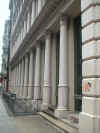 |
New York
Architecture Images-Soho 83-7 Grand St. |
|
architect |
William Hume |
|
location |
83-7 Grand St. ,s.w. corner Greene St. |
|
date |
1872 |
|
style |
Serene Tuscan over elaborate Corinthian. Renaissance Revival |
|
construction |
Cast Iron Facade |
|
type |
|
|
|
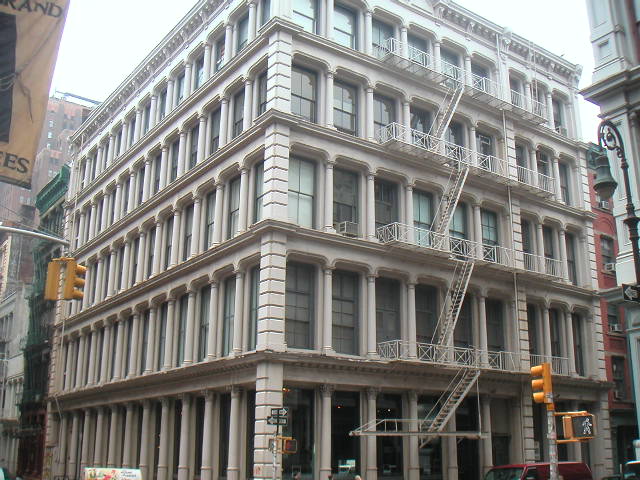 |
|
images |
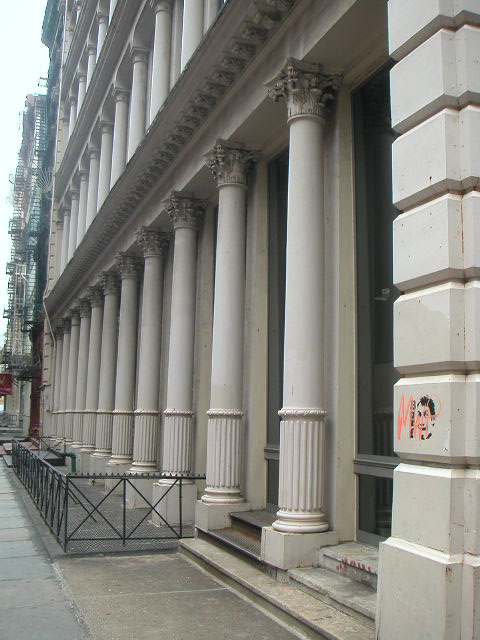 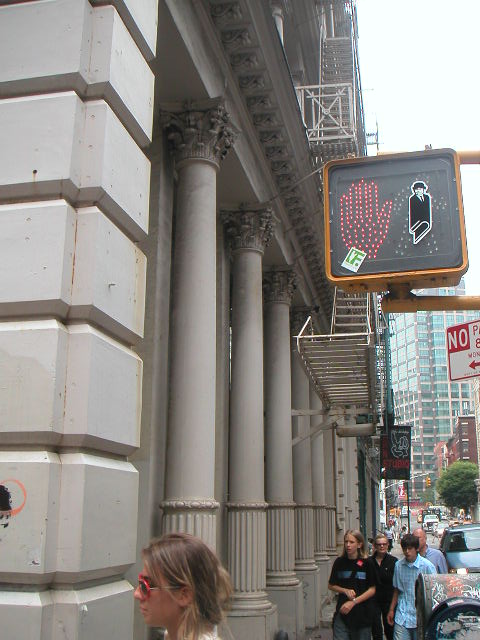 |
|
|
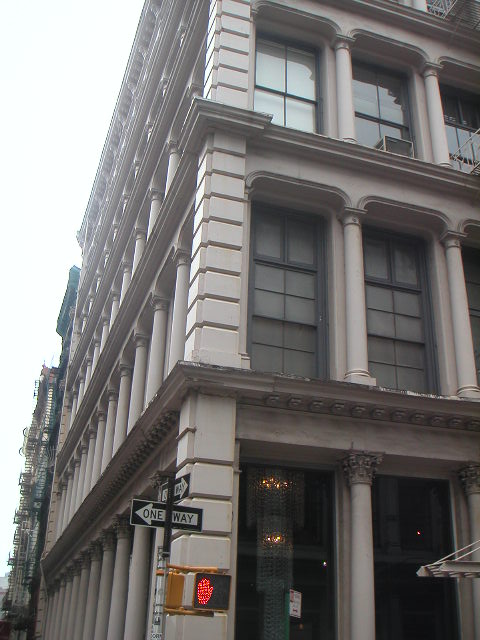 |
|
Streetscapes/134-40 Grand Street; A Large
Cast-Iron Remnant of SoHo's Artist Days By CHRISTOPHER GRAY Published: January 4, 2004, Sunday ALTHOUGH luxury has overtaken the old SoHo of declining industries and struggling artists' co-ops, at least one remnant exists of the gritty days, and it's a big one: the six-story cast-iron 134-40 Grand Street, at the northeast corner of Crosby and Grand. Its great mansard roof was stripped of ornament about 40 years ago, and even repair work in progress will not change the sense that the building is a remembrance of SoHo past. In 1870, Charles Hastings, a clothing manufacturer, began construction at Crosby and Grand on the site of the old Grand Street Presbyterian Church, and one of the neighborhood's most imposing works of architecture was created. Directory listings of the period indicate that the building was shared by several businesses, including Benedict, Hall & Company, boot makers, and Ivison, Blakeman, Taylor, publishers. The cast-iron front is deep and rich, and the mansard roof, with an iron-crested cupola, makes the building stand out, especially on its corner site. The building's architect was William Field & Son; the iron foundry is not known. Newspaper articles of 1879 indicate that another tenant was the dry-goods firm Hinck & Company. In that year a fire destroyed the building across the street, at the northwest corner of Grand and Crosby. Its Crosby Street wall fell and shaved off much of 134-40 Grand's Crosby Street facade, ''as if it were pasteboard,'' The New York Times said. The debris killed Fireman John Reilly of Engine Company 17. A father of five, he had been standing in front of the Hinck & Company windows on Crosby Street. In the 1890's, one tenant was the St. John-Kirkham shoe company. SOHO saw little new construction after 1900, and a $25,000 project planned in 1937 by the architect Ely Jacques Kahn to remodel the entire facade was unusual for the area -- and even that work was not carried out. By the 1960's the area appeared to be in terminal decline, and artists began taking over the loft spaces. Telephone directories in the mid-1970's list mostly businesses at 134-40 Grand like the Hercules Drop Cloth Company, but there were also a few artists, including Dorothea Rockburne. The building went co-op in 1977. SoHo was zoned for manufacturing, and at first artists tried to live there surreptitiously. But in the early 1980's, the city permitted working artists to occupy manufacturing space. Since then the SoHo streets have evolved from hand trucks and packing bales to fashion goods and fancy restaurants, and its buildings have evolved along similar lines. Across the street at 30 Crosby, the Loft is a luxury building with a wine cellar in the basement and multilevel penthouses -- the singer Lenny Kravitz bought one in 2000 for $8 million. But, a block east of Broadway, 134-40 Grand continues as a remnant of the old SoHo. On the ground floor, Beau Label, a label printing company founded by Vincent Melapioni, hums with the sound of printing presses, while truckers drop off and pick up supplies through the front door. Mr. Melapioni remembers when ''the artists in SoHo had hot plates -- now SoHo is full of marble kitchens.'' No concierge is on duty. A sign above the buzzers advises that the ''bell does not work in rain.'' The hallway has grimy, dusty walls, with what appear to be the original 1870 stairs going all the way up, and the handrail and balusters are burnished to a deep gloss. The open-cage elevator, at least 15 feet high, squeaks up and down the tracks. Wendy Friedman's loft on the fifth floor is flooded with light from the south and west. A multimedia artist, she also rents her apartment out for photography and film shoots and corporate retreats. Ms. Friedman's bedroom walls are covered with dozens of phrases she has overheard -- like ''can't see Kansas City tonight'' -- outlined in clothesline, pushpins, pencil dots and twisted chicken wire. SHE lives there with her daughter, Rachel Soleil, 15; the Web site www.SoHoSoleil.com has photographs of her space. A cast-iron cornice outside her window has been opened for repairs. Just visible inside in typical 19th-century script are the painted letters ''sby, Gran,'' almost certainly part of the iron foundry's labeling for shipment and assembly at Crosby and Grand. Another shareholder, Kristian Roebling, is a great-great-grandson of Washington Roebling and Emily Roebling, who together built the Brooklyn Bridge, and great-great-great-grandson of John Roebling, who designed it. His loft is packed with a wide collection of arcana: an Elvis bust; a Flexible Flyer fitted with chrome exhaust pipes; a cow pelvis; a protest banner given to him by a student in Tiananmen Square the day the tanks rolled in (Mr. Roebling was there as a cameraman). A musician and producer, he and some friends formed their own CD label, Brigade Records. ''It's far less lucrative but much more satisfying than being batted around by the labels,'' he said. ''This is a real holdout from the SoHo of the 1970's. It's still a bunch of scrappy people spending time in their spaces creating art.'' SoHo has many fewer manufacturers than it used to, but Beau Label remains, with 28 employees. It is a co-op shareholder, and Mr. Melapioni is the building's nominal archivist, posting old pictures in the lobby. He appreciates the engineering and design that went into the building in 1870; he has kept the original heavy, sagging wooden doors, knows that the original iron shutters are rolled up in the ceiling, and has carefully preserved the ornate column capitals in his high space, even after he installed a mezzanine. The SoHo-Cast Iron Historic District includes the west side of Crosby Street, but excludes the east side and 134-40 Grand. About 10 years ago, Mr. Melapioni saw a large white stone plaque -- previously unnoticed -- that had been pried out of its position in the backyard retaining wall, as if vandals had tried to steal it. He rescued the stone, a marble tablet bearing the name ''Grand Street Presbyterian Church,'' and mounted it in the lobby. Joan Miller, the co-op's board president, said that the current repair project is designed to fix leaks in the mansard. Robert S. Grossman, an artist, has lived in the area since 1962 and says that the mansard was stripped in the mid-1960's; he recalls decorative monograms that might have been Hastings's initials. THE building is restoring some elements of the mansard's missing and damaged ironwork and a semblance of the slate mansard roof, using rubber tiles. But it will be a far cry from some of the detailed restorations of recent SoHo. Mr. Melapioni said that increased restrictions on parking, loading and unloading had made things difficult. ''This used to be the printing hotbed of New York -- that's why artists moved here,'' he said. ''This was originally a commercial area. But now people in this area are looking for doormen.'' Published: 01 - 04 - 2004 , Late Edition - Final , Section 11 , Column 1 , Page 5 Copyright New York Times. |
|
|
links |
|